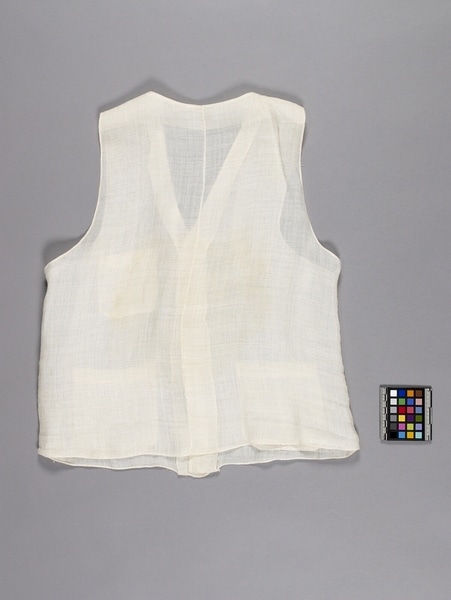Vest Item Number: Ed1.305 from the MOA: University of British Columbia


Description
White ramie vest with a V-neck and centre front closing with four white plastic buttons. The lower edge curves downward in the centre front. There are pockets sewn on each side of the centre opening and a third smaller pocket on the upper left side. There is a centre back seam. All hems and seams are very narrow.
History Of Use
Such vests were part of full sets of men’s summer formal wear. They were worn over the upper body garment “Jo-go-ri”. They represent the influence of western clothing on Korea after the opening of Korea to the outside world in the late nineteenth century. The pockets and buttons are western concepts. The ramie fabric was hand-woven by masters who were members of guilds.
Specific Techniques
The ramie fabric (mosi) was hand-woven to a narrow loom width. All the seams and finishing, including the buttonholes, are machine-sewn.
Narrative
Most of the clothing in the J. McRee Elrod Collection was made for him and his family by friends while they were living in Korea, much of it by Kim, Sung Sook. She and her family lived cooperatively in the same house as the Elrod family. While they were there, the Elrods preferred to wear Korean clothing on very cold days and for social occasions. They found it to be more comfortable than western clothing in cold weather, as public buildings were unheated in the period immediately following the Korean War. It also was more comfortable for floor seating in Korean homes, and easier to store with limited furniture than western clothing.
Item History
- Made by Sung Sook Kim (Maker) in Korea between 1955 and 1960
- Collected between 1955 and 1960
- Owned by J. McRee Elrod before October 13, 1976
- Received from J. McRee Elrod (Donor) on October 13, 1976
What
- Name
- Vest
- Identification Number
- Ed1.305
- Type of Item
- vest
- Material
- ramie fibre, cotton fibre and plastic
- Manufacturing Technique
- spun, dyed, woven, cut and sewn
- Overall
- height 65.0 cm, width 32.0 cm
Who
- Culture
- Korean
- Creator
- Sung Sook Kim (Maker)
- Previous Owner
- J. McRee Elrod
- Received from
- J. McRee Elrod (Donor)
Where
- Holding Institution
- MOA: University of British Columbia
- Made in
- Korea
When
- Creation Date
- between 1955 and 1960
- Collection Date
- between 1955 and 1960
- Ownership Date
- before October 13, 1976
- Acquisition Date
- on October 13, 1976
Other
- Item Classes
- textiles
- Condition
- good
- Accession Number
- 0335/0001 c